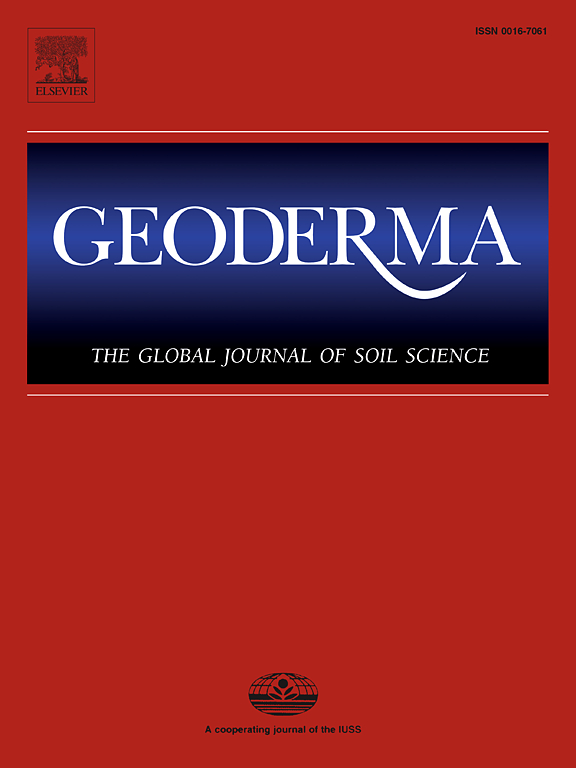Stimulatory effects of nutrient addition on microbial necromass C formation depend on soil stoichiometry
IF 5.6
1区 农林科学
Q1 SOIL SCIENCE
引用次数: 0
Abstract
Nutrient availability strongly influences soil organic carbon (SOC) accumulation through microbial necromass C (MNC) formation. However, the effects of nutrient addition on regulating MNC formation in soils with distinct stoichiometric ratios are not well understood. Soil samples were collected from a long-term (>40 years) wheat-maize rotation field trial, without and with nutrient management, which exhibited high and low C:nutrient (N and P) ratios, respectively. These soils were incubated with 13C-labeled glucose (labile C) and nutrients (N and/or P) for 63 days. A greater proportion of labile C was converted into MNC, especially bacterial necromass C, in the low C:nutrient soil (averaging 32 %) than in the high C:nutrient soil (averaging 25 %). In the high C:nutrient soil, N and/or P addition significantly increased newly formed MNC (13C-MNC) by 8–33 %, whereas in the low C:nutrient soil, N and P addition had a marginal and negative effect on 13C-MNC, respectively. The 13C-MNC content was negatively correlated with resource stoichiometric ratios (dissolved organic C (DOC):mineral N, microbial C:N imbalance, and DOC:available P), and enzyme activities (β-1,4-glucosidase, leucine amino peptidase, N-acetyl-glucosaminidase, and alkaline phosphatase). These results suggest that the increase in MNC is primarily due to the alleviation of N and P limitations. Furthermore, the 13C-MNC content was positively correlated with the 13C-phospholipid fatty acids content, indicating that enhanced microbial anabolism, especially bacterial anabolism, promoted MNC formation. Collectively, our findings emphasize the critical role of soil stoichiometry in regulating microbial metabolism and MNC formation in response to nutrient addition. These insights have significant implications for optimizing nutrient management to enhance SOC sequestration in arable soil.
营养添加对微生物坏死块C形成的刺激作用取决于土壤化学计量学
养分有效性通过微生物坏死团C (necromass C, MNC)的形成强烈影响土壤有机碳(SOC)的积累。然而,在不同化学计量比的土壤中,营养添加对MNC形成的调节作用尚不清楚。土壤样品采集于长期(>;40年)小麦-玉米轮作大田试验中,在不进行和进行养分管理的情况下,土壤样品分别表现出高和低的C:养分(N和P)比。这些土壤与13c标记的葡萄糖(不稳定C)和营养物质(N和/或P)孵育63天。在低碳营养土壤中,不稳定碳转化为MNC的比例(平均为32%)高于高碳营养土壤(平均为25%),尤其是细菌坏死块碳。在高碳土壤中,N和P的添加显著增加了新形成的MNC (13C-MNC) 8 - 33%,而在低碳土壤中,N和P的添加对13C-MNC的影响分别为边际和负向。13C-MNC含量与资源化学计量比(溶解有机碳(DOC):矿物氮、微生物碳:氮失衡、DOC:速效磷)和酶活性(β-1,4-葡萄糖苷酶、亮氨酸氨基肽酶、N-乙酰氨基葡萄糖苷酶和碱性磷酸酶)呈负相关。这些结果表明,MNC的增加主要是由于N和P限制的缓解。13C-MNC含量与13c -磷脂脂肪酸含量呈正相关,说明微生物合成代谢尤其是细菌合成代谢的增强促进了MNC的形成。总的来说,我们的研究结果强调了土壤化学计量在调节微生物代谢和MNC形成方面的关键作用,以响应营养添加。这些见解对优化养分管理以提高耕地土壤有机碳的固存具有重要意义。
本文章由计算机程序翻译,如有差异,请以英文原文为准。
求助全文
约1分钟内获得全文
求助全文
来源期刊

Geoderma
农林科学-土壤科学
CiteScore
11.80
自引率
6.60%
发文量
597
审稿时长
58 days
期刊介绍:
Geoderma - the global journal of soil science - welcomes authors, readers and soil research from all parts of the world, encourages worldwide soil studies, and embraces all aspects of soil science and its associated pedagogy. The journal particularly welcomes interdisciplinary work focusing on dynamic soil processes and functions across space and time.
 求助内容:
求助内容: 应助结果提醒方式:
应助结果提醒方式:


